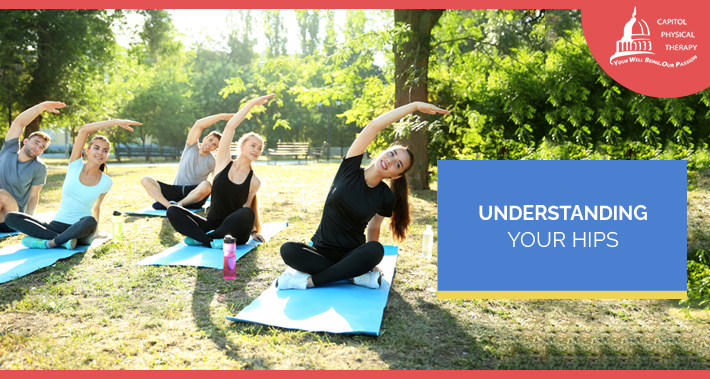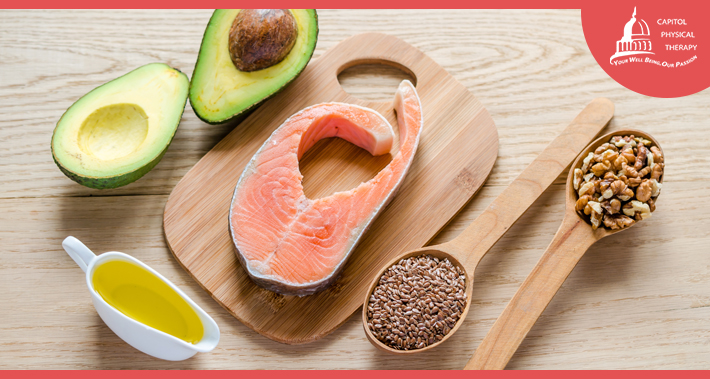
Hips!
We use them to stand, run, sit, jump, dance, and so much more.
But how hip are you when it comes to your acetabulofemoral joints?
What are hips made up of?
How do you prevent hip injuries?
Keep reading to learn more about your hips, from how they fit together to how to keep them healthy.
If you want to get a leg up on hip health and how to improve it, an orthopedic health physical therapist here at Capitol Physical Therapy will be happy to help.
What Are Your Hips?
Your hips are large joints that attach your legs to your pelvic floor and the trunk of your body.
More than just a couple of bones, your hips are made up of:
- Bones
- Cartilage
- Muscles
- Ligaments and Tendons
- Synovial membranes and synovial fluid
These parts work together to help you stand, sit, and move.
When all of these parts are working well, they protect one another from injury and wear and tear.
Let’s take a look at the different parts.
Hip Bones
Your hips are also known as the acetabulofemoral joints, where the acetabulum meets the femoral head.
You’ve probably heard of the femur – we’ve talked about it in this article in the past.
Your acetabulum, also called the cotyloid cavity, is part of the structure of the hip bone and pelvis.
It gets its name from a medieval word for a small dish – abulum – used to serve vinegar – acetum.
Three regions of the pelvis – the ischium, ilium, and pubis – fuse together to create this shallow bowl shaped curvature.
If you think of your hip as a ball and socket joint, the acetabulum is the socket, and the head of the femur is the ball.
Hip Cartilage
The femoral head and the acetabulum are both lined with a special type of cartilage – articular cartilage.
Articular cartilage is strong, flexible, and very smooth and slippery.
The slippery surface of the articular cartilage makes it easy for your femur to glide against the acetabulum when you move.
Your hip also has a labrum, a strong, stretchy ring of cartilage that lines the outer edge of the acetabulum.
This ring makes your joint deeper,and its elasticity adds flexibility to your joint.
Hip Muscles
Your hip joint is connected to several surrounding muscles.
These muscles support your hip and help you move smoothly and safely.
The muscles groups connected to your hip are:
- Adductors – your inner thigh muscles
- Gluteal muscles – your buttock, or the back of your hip
- Hamstrings – several muscles that extend along the back of your thigh to your knee
- Iliopsoas – a group of three muscles connecting the lower back to the top of the femur
- Quadriceps – four muscles that make up the front of your thigh
Hip Ligaments and Tendons
Ligaments and tendons help to keep all the pieces of your hip together.
Your ligaments connect your femur to the pelvis, holding the bone in place in the socket.
Tendons connect your femur and pelvis to the surrounding muscles.
When tendons and ligaments are strong and flexible, they control movement and provide structure, reducing stress on your hip.
Synovial Membrane And Fluid
Your synovial membranes and synovial fluid help keep your joint connected and lubricated.
You have several synovial joints in your body.
These are joints in which the area where bones come together is encapsulated by a thin membrane – the synovial membrane.
Synovial fluid keeps your bone and cartilage from grinding together.
When your joint is at rest, your synovial fluid is stored in your cartilage.
When you move, synovial fluid is squeezed out of your cartilage and fills the cavity created by the synovial membrane.
Where Is Your Femur?
Your femur is your thigh bone.
It is the longest bone in your body, and generally the strongest.
The upper end, the femoral head, is the part of the femur that connects to the pelvis to form the hip joint.
Your femur extends all the way down to your knee.
The lower end of the femur is a larger section of bone that forms the upper part of your knee joint.
What Do Your Hips Do?
The hip is a unique joint – it’s a strong, weight bearing joint, but it also has an incredible range of motion.
Your hip can flex, as it does when you raise your leg to take a step forward.
Your hip can also extend, as it does when you push off into your next step.
Moving your leg laterally – from side to side – requires abduction or adduction of your hip.
If you move your leg away from the midline of your body, it’s in abduction.
Move your leg in towards the other leg and you are in adduction, activating your hip using your inner thigh.
Finally, your hip can rotate both internally and externally.
Internal rotation happens when you turn your leg so that your toes point inward.
External rotation occurs when you turn your toes out, as a ballet dancer might do when they plie.
If you do any sort of athletic outdoor activities, from running to yoga to pilates to swimming and many more, thank your hips.
Common Health Issues With Your Hips
Many people experience hip issues, especially as the cartilage and tissues of the joint wear down with time.
Hip pain can have many causes, including injury, disease, and wear and tear from age, sports, or physically demanding work.
Some of the most common health issues with hips are osteoarthritis, rheumatoid arthritis, and bursitis.
1. Osteoarthritis
Osteoarthritis is known as ‘wear and tear’ arthritis.
When the cartilage in the hip wears down the femur and acetabulum are no longer protected.
Without articular cartilage, your joint cannot move as smoothly.
When you move, the bones of your hip will rub together, causing pain and stiffness.
RELATED Physical Therapy Treatments For Osteoarthritis
2. Rheumatoid Arthritis
Rheumatoid arthritis is an autoimmune condition that leads to swelling, aches, and stiff joints.
Your synovial membrane becomes irritated and produces too much fluid.
Doctors don’t yet know why your body might react this way.
The excess fluid in your joints damages the cartilage, leading to pain and stiffness.
RELATED Physical Therapy Treatments For Rheumatoid Arthritis
3. Bursitis
Bursa are fluid filled sacs that pad your joints and reduce friction between different tissues in your body.
Bursitis occurs when one of these sacs becomes inflamed.
You have two bursae in each of your hips, the ischial bursa and the trochanteric bursa.
The ischial bursa is deep in your body and prevents friction between the pelvis and the gluteal muscles.
The trochanteric bursa pads the outer side of the hip.
Separated from the joint by tissue and bone, inflammation of the trochanteric bursa is much more common than ischial bursitis.
RELATED Physical Therapy For Bursitis In Your Hips

How To Keep Your Hips Healthy
Hip health relies on strength, flexibility, a good supply of nutrients, and a little bit of protection.
Exercise, eating a well balanced diet, and protecting your hips from damage are great ways to support your hip health.
1. Exercise
Nothing beats exercise when it comes to hip health.
Strength and flexibility in the muscles and tendons of the hip are key to keeping the joint stable and well supported.
Look for stretches, weight bearing exercise, or activities that help you to work on balance, range of motion, and flexibility.
If you already have some hip pain or arthritis, low impact activities can strengthen the joint without irritating it.
Try walking, yoga, Pilates, cycling, swimming, or aquatic aerobics for exercise that doesn’t stress your joints.
Avoid high impact sports or activities that require a lot of intense joint movement.
If you experience sharp or shooting pain while exercising, it’s best to stop immediately and talk to your physical therapist.
2. Eat Well
Eating a diet that is rich in nutrients can help prevent the inflammation that contributes to many people’s hip pain.
Foods that are rich in Omega 3 fatty acids are great for inflammatory conditions and overall health.
Omega 3 fatty acid rich foods include:
- Olive oil
- Avocado
- Walnuts
- Flax seeds
- Fatty fish like salmon, tuna, and herring
Antioxidant rich foods like berries and dark leafy greens can also protect your body from inflammation and tissue damage.
3. Protect Your Joints
Good posture and preventing injuries are secret weapons when it comes to hip health.
Standing, walking, or sitting with poor posture places stress on the muscles connected to your hip joint.
Staying in one position for a long time, especially if you do it on a regular basis, can also increase the wear on your joints.
Be mindful of your alignment and positioning and be sure to take stretch breaks.
Make sure your home and workspace are well lit, have grab bars and railings where needed, and are free of tripping hazards.
Book Your Appointment With Capitol Physical Therapy Today
Taking care of your hips goes a long way in terms of protecting your overall health and longevity.
Whether you live with hip pain or want to prevent it, a physical therapist can help you build a plan.
A physical therapist can identify where you need to improve your strength and flexibility.
They can also help you adapt your posture and movement to relieve pressure on already achy joints.
To take the first step toward healthier hips, book your appointment with Capitol Physical Therapy today.
1331 H St NW #200,
Washington, DC 20005
- https://g.page/capitolptdc
9560 Pennsylvania Ave. # 202,
Upper Marlboro, MD 20772
- https://goo.gl/maps/zjL4NnnuThRhrcS86
Capitol Physical Therapy offers orthopedic and other pain related solutions, with our versitile team of physical therapists in Washington, DC